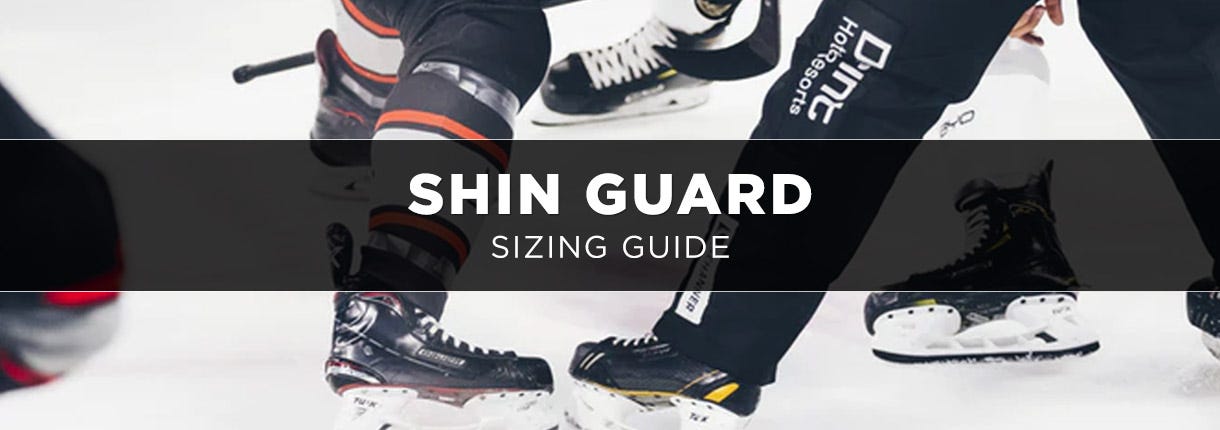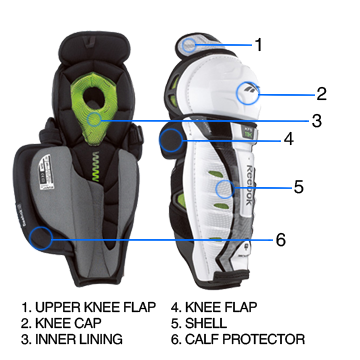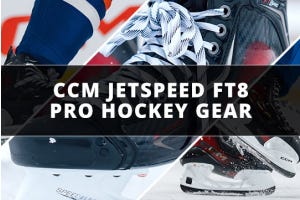Hockey Shin Guard Sizing Chart & Guide: How to Measure Shin Guards

As their name suggests, ice hockey shin guards are meant to guard a player's shins and lower leg from fast-flying pucks and sticks. In order to achieve the ultimate protection and comfort, it's important to know how to size shin guards properly.
Here, we'll give you everything you need to know about shin guards – sizes, comfort and finding the right fit. We'll take a look at:
- A Hockey Shin Guard Sizing Chart
- How to Measure Hockey Shin Guard Sizes
- Parts of a Hockey Shin Guard
- Hockey Shin Guard Brands
- Common Hockey Shin Guard Questions
Hockey Shin Guard Sizing Chart
Shin guards are a vital piece of equipment for any serious hockey player. With pucks flying up to 100 mph, there’s no arguing: ice hockey is a fast game. Pucks are shot hard, sticks are in constant motion and sometimes the only thing to save a player from serious injury is properly fitted gear…shin guards included. But with so many hockey shin guard sizes, it can be hard to know which one is best. Using this shin guard size chart, you can find proper sizing guidelines, from youth shin guard sizing all the way through adult hockey shin pad sizes, just by using height and leg measurements.
| Hockey Shin Guard Sizing Chart | |||
|---|---|---|---|
| Shin Guard Size | Knee Cap to Ankle (in.) | Height (ft.) | |
| Youth | 7" | 6 - 7" | 3'3" - 4'5" |
| 8" | 7 - 8" | 3'9" - 4'7" | |
| 9" | 8 - 9" | 4'3" - 4'9" | |
| Junior | 10" | 9 - 11" | 4'5" - 4'11" |
| 11" | 10 - 11" | 4'7" - 5'1" | |
| 12" | 10 - 12" | 4'9" - 5'4" | |
| Senior | 13" | 12 - 13" | 5'5" - 5'9" |
| 14" | 13 - 14" | 5'7" - 5'11" | |
| 15" | 14 - 15" | 5'9" - 6'1" | |
| 16" | 15 - 16" | 5'11" - 6'3" | |
| 17" | 16 - 17" | 6'1" - 6'3" | |
| 18" | 17 - 18" | 6'3" + | |
How to Measure Hockey Shin Guard Sizes
Follow these steps:
- Put on your hockey skates and tie them as if you were ready to play.
- Sit down on a chair or bench with your feet flat on the floor and legs bent at the knee at a 90-degree angle.
- Measure the distance from the top of your skate boot to the center of your knee cap.
- The distance you measure, rounded up to the nearest inch, is a good starting point for knowing what size shin guard you need.
Keep in mind, not every hockey player of the same height has the same sized legs, so going strictly by our shin guard size chart may not give you the perfect fit, but it really is a great place to start if you’re not sure what size to go with.
There is room to go up or down a size based on personal preference. Some players prefer to wear the shin guard over the tongue of the skate, in which case they may go with a larger size. Other players might like them to fit under the tongue of the skate, and they can generally go with a smaller size.
The important thing to remember is to make sure that neither the knee cap, nor the ankle, is exposed. If your shin guards are too small, you may end up with parts of your leg exposed to slashing sticks and 100-mph pucks. And if your shin guards are too big, you risk restricting your movement and an uncomfortable fit.
Parts of a Hockey Shin Guard
Hockey shin guards can be broken down into six main parts.
- Upper Knee Flap: The upper knee flap protects the top of the knee. It’s flexibly-attached to allow it to move when the leg flexes.
- Knee Cap: The knee cap is composed of hard material to protect the knee from pucks, sticks and falls.
- Inner Lining: The inner lining is padded and made from soft material to provide a comfortable fit.
- Knee Flap: The knee flap is flexible enough to move as a player skates while protecting the sides of the knee.
- Shell: The shell covers the shin and can protect against a flying puck or a slashing stick.
- Calf Protector: The calf protector provides protection for the back of a player's leg.

Hockey Shin Guard Brands
As with all equipment, there are many brands of shin guards to choose from. Often, what it generally comes down to is personal preference based on comfort and brand loyalty. But, there are a few brands well-known in the world of hockey that players love and gravitate to most for a variety of reasons.
- Bauer – variety of styles and fits to choose from, maximized protection, comfort and fit.
- CCM – lightweight without compromising any protection, great movement.
- Warrior – multiple styles available, known for their Polygiene odor-fighting technology.
Common Hockey Shin Guard Questions
How to Clean Hockey Shin Guards
Hockey shin guards can be washed in your washing machine. Use a bleach-free detergent and wash on a gentle cycle. To help remove odors, you can add white vinegar at the same time as detergent. Make sure you air dry your shin guards, rather than using your clothes dryer.
How to Tape Hockey Shin Guards
In order to ensure a snug fit and prevent shin guards from moving during play, most players use sock tape to keep their shin guards in place. There are a few different ways to tape for a tight fit. Follow these steps:
- Make sure you tape over your hockey socks. This will hold both your socks and shin guards in place.
- Start just below the knee and tape around the leg multiple times.
- Repeat this process just above the ankle or mid-calf.
- Some players will add an extra diagonal wrap of tape between the two
Taping your shin guards is a personalized process, so it's ok to experiment to find what’s most comfortable for you.
What are hockey shin guards made out of?
Modern hockey shin guards are made from numerous types of materials. Some shin guards are constructed from composite plastics, fiberglass and polyurethane.
Looking for new shin guards? HockeyMonkey has all the gear you need, and with dozens of brands and styles to choose from, you’re sure to find the right pair of shin guards that are both comfortable and protective.











